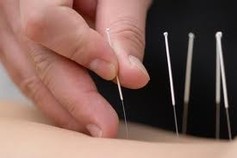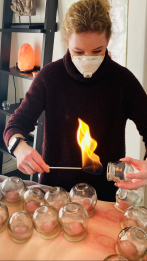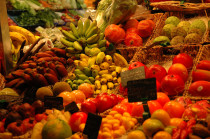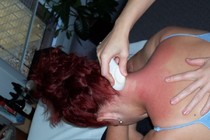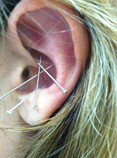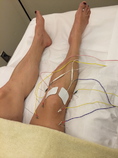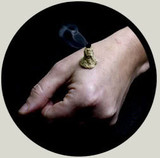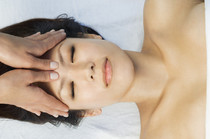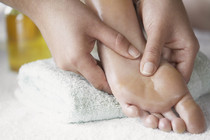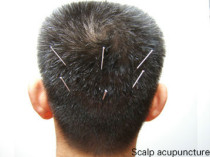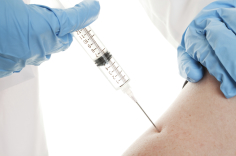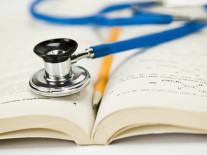Services
My services at a glance. Click on each link to find out more about each modality.
What are all of these therapies?
- Acupuncture is a very old form of medicine based on TCM (Traditional Chinese Medicine) principles of balancing and harmonizing the body. Pain, discomfort, or other imbalances in the body are viewed as blockages of blood and Qi ("chee"), or energy in the body. Acupuncture is the use of thin, single-use, disposable needles that are inserted into the body at various acupoints to release these blockages and restore balance to the body. There are over 350 acupuncture points on the body, and it is my job as an acupuncturist to correctly diagnose the problem or "blockage," and select the appropriate points to best fix it. The number of points selected in a treatment varies depending on the individual patient and the issue they are experiencing.
- Although many people are afraid of needles or have concerns about the pain that needles tend to cause, acupuncture is actually not particularly painful. Acupuncture needles are extremely thin and flexible, unlike needles used for injections or blood collection. Some patients do not even feel it when the needles are inserted. Others experience a quick prick, and then the feeling dissipates. Sometimes patients feel a deep throbbing or pulsing sensation when the needle "grabs" the Qi, but this feeling also only lasts momentarily and is actually a sign that the needle is doing its job and moving stuck energy in the body.
- Click the link to find out about the conditions that acupuncture treats, or CLICK HERE to go to my "Frequently Asked Questions" page.
- Chinese herbology dates as far back as the Qin and Han Dynasties of China, from 3rd Century B.C. to 3rd century A.D. Chinese herbology uses similar principles to acupuncture in the treatment and prevention of disease. Chinese herbal medicine "consists of understanding and mastering theory, strategy, formulas, and substances. This means that once one identifies a patient's problem, the strategy of treatment, the formula that incorporates that strategy, and the specific herbs that constitute the formula for that particular patient will naturally follow."--Bensky. As with acupuncture treatment, it is my job as an herbalist to identify the patient's problem, and pick a formula that will help or fix that problem.
- The substances used in the practice of Chinese herbology are mostly plants, but can also be minerals, and even animal and human products. Individual herbs are
usually combined together to make a formula, which is then taken by the patient under the direction and supervision of the practitioner. Formulas come in various forms, from raw herbs, to herbal
teas, to decoctions, to pills, to powder. Which type of formulation the patient takes is usually up to the patient, the easiest and most convenient usually being pills.
- Examples of some commonly used Chinese herbs that you probably know include: ginger, astragalus, ginseng, cinnamon, and licorice.
- For more extensive information, including a list and explanations of commonly used Chinese herbs, click the following link:
- While most herbal formulas do not cause any side effects, some issues can occur when taking herbal formulas, in which case the practitioner should be immediately notified so as to recommend discontinuation of the formula, or adjustment of the dosage. The most common side effect is gastrointestinal disturbance, but other side effects can include dizziness, rash, or nervousness. Usually, once the dosage has been adjusted, no further problems will occur. Also, taking the herbs after meals, rather than before, can prevent side effects. In general, however, the side effects of Chinese herbs are exponentially less than those of prescription drugs.
- Click the link to find out about the conditions that Chinese herbology treats, or CLICK HERE to go to my "Frequently Asked Questions" page.
- Cupping is a technique that uses heat, or fire, to create local suction on the skin. The way it works is that an alcohol swab or alcohol soaked cotton ball is lit with a flame, which is then waved quickly inside the cup, and then the cup is placed directly on the skin of the patient. The flame removes all the oxygen from within the cup, creating a small vacuum that gently draws the skin up into the cup. If oil has been placed on the skin beforehand, the cups can be moved around, usually along either side of the spine. This is called "moving cupping." Stationary cups can also be left on the body for 5 to 10 minutes.
- The suction created can cause swelling or leave bruise-like marks on the skin, but these marks are usually not painful. Some patients report feeling a soreness the following day similar to that of a deep tissue massage, but this usually only lasts for a day. The bruise marks can sometimes take up to a week to fade, but almost never longer than that.
- The principle behind cupping is that it mobilizes blood flow to promote healing. "In China, cupping is used primarily to treat respiratory conditions such as bronchitis, asthma, and congestion, arthritis, gastrointestinal disorders, and certain types of pain. Some practitioners also use cupping to treat depression and reduce swelling. Fleshy sites on the body, such as the back and stomach (and, to a lesser extent, the arms and legs), are the preferred sites for treatment." --Acupuncture Today
- "We are what we eat" really is true, and nutritional counseling can help you feel your absolute best. Every type of food has its own therapeutic properties, and depending on a person's individual constitution, those food properties can enhance health, or add to dysfunction in the body. The idea behind nutrional counseling is to evaluate each individual's constitution, what their current diet looks like, and to determine which foods are beneficial or detrimental to them. We then figure out how to adjust the diet by eliminating problem foods and adding foods that promote health and well being in the body.
- Gua-Sha is a technique that uses a Gua-Sha tool to scrape the skin of the patient to release pathogens from the body. In the past, Gua-Sha tools varied from soup spoons, to the smooth edge of a coin, to well-honed animal bones, to jade. These days the tools are made out of plastic or stone usually, having smooth or tooth-like edges. The smooth edge of the tool is placed against the oiled skin surface of the patient (although sometimes oil is not used), pressed down firmly, and then moved down the muscles, or along the pathway of the acupuncture meridians. Each stroke is about 4-6 inches long. It is usually done on the neck or upper back and shoulders of the patient.
- The pressure of the tool and the scraping technique cause extravasation of blood from the peripheral capillaries and may result in sub-cutaneous blemishing, or ecchymosis. In Chinese medicine, this is known as "Sha." These marks are similar to those caused by cupping, and usually take about 2-4 days to fade. The marks caused by Gua-Sha are typically not painful.
- Gua-Sha promotes the flow of qi and blood and moves fluids. Raising "Sha" removes blood stagnation considered to be pathogenic, promoting normal circulation and metabolic processes.The patient experiences immediate relief from pain, stiffness, fever, chill, cough, nausea, and so on. Gua Sha is valuable in the prevention and treatment of acute infectious illness, upper respiratory and digestive problems, and many other acute or chronic disorders.--Guasha.com. Gua-Sha can also be used to ventilate and release heat from the body. It is especially useful in the summer for sun stroke or heat stroke.
- Auricular acupuncture is based on the principle that the entire ear represents the body and its illnesses. It is considered a microsystem or microcosm of the body as a whole. Auricular acupuncture is not based on the meridians in the body the way traditional acupuncture is, but rather each point represents actual organs and parts of the body. "When an internal organ or a part of the body is diseased, reactions can be detected at the cooresponding areas on the auricle. For example, a reaction can be detected at Point Stomach when the stomach is ill."--Chinese Acpuncture and Moxibustion. Therefore, treating the Stomach point of the ear, will treat the patient's stomach. The entire body can be treated by finding which points are sensitive on or in the ear, and needling them with thin, very short acupuncture needles. Combining a few points on the ear together can treat more complex diseases in the body.
- Auricular acupuncture treats all of the same diseases as regular acupuncture, but treatments are less complex and shorter in duration. In fact, the patient can be treated while sitting up in a chair. There are rarely any negative side effects, although fainting and light-headedness can occur, especially if the patient hasn't eaten before treatment.
- Auricular acupuncture is especially effective in treating drug addiction, including smoking and alcoholism. It can also help with weight loss and controlling food cravings. For these types of issues, the NADA protocol is used, which uses the same 5 ear points for every treatment, with treatments occurring daily or up to twice per day. For more information on acupuncture and drug addiction, click on the following link to see an article by the Acupuncture Today publication.
Electrostimulation/Electroacupuncture:
- Electrostimulation or electroacupuncture is the use of an electrostimulation machine (E-Stim) to more aggressively activate acupuncture needles that have already been inserted in the body. Sometimes when energy is really stuck, and a patient is experiencing a high level of pain, it is necessary to stimulate the needles with more force than a manual technique to release the blockage. Small electronic leads that are attached to the E-Stim machine are clipped onto the inserted acupuncture needles, and an electric current is sent from the machine, to the needles, and throughout the body. The strength and pace of the current is selected by the acupuncturist and the patient together. Several pairs of needles can be stimulated simultaneously, usually for no more than 30 minutes at a time.
- E-Stim in the body mostly feels like a tingling sensation, similar to the feeling when your foot or other part of your body "falls asleep" momentarily. Sometimes, if the current is strong enough, it can cause muscles to "jump" or twitch because it is stimulating the muscle bundles and causing muscle contraction, but if this is uncomfortable for the patient, the current can be adjusted. In most cases, however, the patient doesn't feel anything at all.
- Electroacupuncture "has been studied for a variety of conditions. It has been effectively used as a form of anesthesia, as a pain reliever for muscle spasms, and a treatment for neurological disorders. Other studies have examined the role of electroacupuncture in treating skin conditions such as acne, renal colic, and acute nausea caused by cancer medications. There is also some evidence that electrical stimulation of acupuncture points activates the endorphin system, which could lower blood pressure and reduce heart disease."--Acupuncture Today
- Electroacupuncture should not be used on patients who have a history of seizures, epilepsy, heart disease, stroke, or on patients with pacemakers.
- Moxa treats and prevents diseases by applying heat to points or certain locations on the body. Moxa is made from a mugwort plant called Artemisia Vulgaris, or Ai Ye in Chinese pin yin. This plant produces leaves which are dried and made into a type of "moxa wool," which is the material used for moxa cones or sticks. The moxa is lit with a match or a lighter, and placed on or near the body, or over an acupuncture needled, to create heat. When burned, "it penetrates all the meridians, eliminating hundreds of diseases."--Chinese Acupuncture and Moxibustion.
- There can be some side effects with moxa, and it must be used with care. It should not be used in patients with excess heat conditions, including patients with high fevers. It should also not be used in the abdominal region of pregnant women, and it shouldn't be used in close vicinity to the head or face. There is a risk of scarring, burning, or blistering if an area gets too hot, but a skilled practitioner should not allow this to happen. Mostly the patient will experience a pleasant warming sensation, and should not feel pain. Moxa should not be used on diabetics or people with limited sensory function because burning is more likely to occur. Additionally, when burned, moxa releases a good deal of pungent smoke, so it should not be used on people with respiratory conditions or sensitivities.
- Moxibustion is "mostly used on people who have a cold or stagnant condition. The burning of moxa is believed to expel cold and warm the meridians, which leads to a smoother flow of blood and qi. In Western medicine, moxibustion has successfully been used to turn breech babies into a normal head-down position prior to childbirth. Other studies have shown that moxibustion increases the movement of the fetus in pregnant women, and may reduce the symptoms of menstrual cramps when used in conjunction with traditional acupuncture."--Acupuncture Today. It can also be used for infertility, erectile dysfunction, vomiting or nausea, and prolapsed organs. Lastly, it can be used to prevent disease, strengthen the immune system, and promote health in general.
- Tui-Na (pronounced "twee nah") is a form of massage or bodywork that has been used in China for centuries. It is a hands-on technique that combines massage, acupressure and other forms of body manipulation. Tui-Na works by applying pressure to acupoints, meridians and groups of muscles or nerves to remove blockages that prevent the free flow of qi. Removing these blockages restores the balance of qi in the body, leading to improved health and vitality.
-
Tui-Na is best suited for "rectifying chronic pain, musculoskeletal conditions and stress-related disorders that affect the digestive and/or respiratory systems. Among the ailments Tui-Na treats best are neck pain, shoulder pain, back pain, sciatica and tennis elbow. However, because Tui-Na is designed to improve and restore the flow of qi, treatment often ends up causing improvements to the whole body, not just a specific area. There is anecdotal evidence that headaches, constipation, premenstrual symptoms and some emotional problems may also be effectively treated through Tui-Na."--Acupuncture Today
- Tui-Na is a vigorous form of massage, so soreness can occur. Additionally, sometimes patients will feel sedated and sleepy after a treatment, or on the other end of the spectrum, some patients will feel euphoric and energized.
-
Patients with osteoporosis or conditions involving fractures, for instance, should not receive Tui-Na. Neither should patients with infectious diseases, skin problems or open wounds.
- Acupressure is essentially the same as acupuncture, without the use of needles. Using massage and pressure, rather than needles, acupoints are stimulated to unblock the channels and meridians of the body. It can be used for the same conditions that acupuncture treats, however, it is not quite as powerful, and results may be more subtle.
- Scalp acupuncture is similar to auricular or ear acupuncture in that the scalp is treated as its own system, or microsystem, meaning that it can be used by itself to treat the rest of the body. The scalp is divided into sections, which include the "motor" area, the "sensory" area, the "vision" area, and a few others. These areas coorespond to parts of the body. Needles are inserted horizontally in and along the lines of these areas, depending on what is being treated, and are stimulated using rapid manipulation or electrostimulation.
- Many disorders can be treated using scalp acupuncture, but it is especially useful for patients experiencing chronic pain, or patients who have had or are recovering from a stroke or other neurological disorder.
- Sometimes patients can experience a heat sensation or intensity during needle manipulation. This usually means that the scalp acupuncture is working, but if it is too intense for the patient, manipulation can be slowed down or stopped completely.
Homeopathic Injections:
- B12 (Energy/Immunity)
- Traumeel (Pain Relief/Inflammation Reduction)
- Engystol (Cold/Virus/Illness Relief)
- Calmvalera (Anxiety/Stress Relief)
- Spascupreel (Muscle Spasm Relief/Stomach Cramp Relief)
- Neuralgo-Rheum (nerve Pain/Disc Protrusion Symptoms)
- Zeel (Pain & Joint Stiffness Relief/Inflammation Reduction)
- Gelsemium-Comp. (Nerve Pain Relief)
- Arnica (Muscle Pain/Stiffness/Bruising Relief)
- Biomedical knowledge is part of most TCM (Traditional Chinese Medicine) school training, and was a large part of my training at Emperor's College. I took classes in anatomy and physiology, Western clinical medicine, pathophysiology, chemisty, biology, and more. I was trained how to read and interpret lab data, and how to help assess a patient's condition based on their signs and symptoms in Western medical terms. I was also trained in CPR and required to take blood pressure, heart rate, and temperature readings on every patient I saw in clinic.
- Most importantly, I was taught how to recognize emergency conditions, and when to send a patient to the emergency room, or to refer them to their Western medical doctor for further assistance.

















